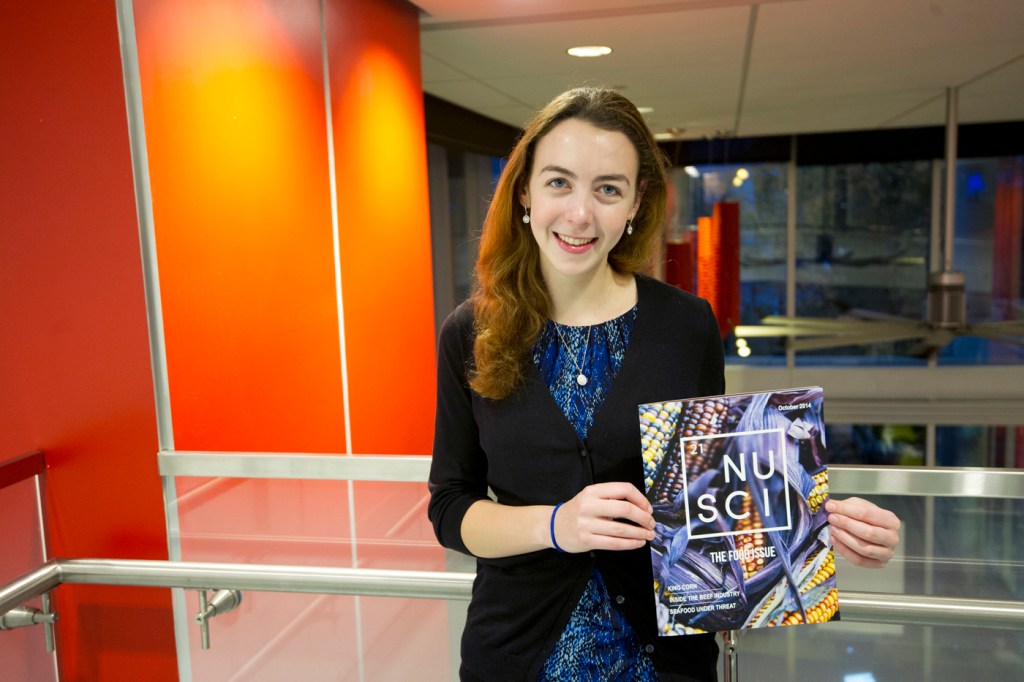The evolution of NUScience

This is a guest blog post by Gwen Schanker, AMD/S’18, a writer and editor for the student-run magazine NUScience. She is pursuing a double major in journalism and biology.
Science writing plays an important role in the intellectual community—it allows everyone with an interest in science to keep up with current developments by reading about them in an interesting, cohesive way. When I arrived at Northeastern in August 2013, I was already an aspiring science journalist. The question was when “aspiring” would become “blossoming” and eventually “prolific.” In other words, I wasn’t sure how to find my niche in the university community, but I was excited to get started.
During my first week on campus, I attended Northeastern’s Activities Fair and discovered that my school had its own science magazine—NUScience. This seemed like the perfect place for me to take a stab at science writing, and, in fact, it was. The following month I published my first scientific clip: an interview with my ultra-cool-Higgs-Boson-researching physics professor, Toyoko Orimoto. Since then, I’ve written more than 10 articles for the magazine and website and have also joined the e-board as an editor.
If you’ve never heard of NUScience—NUSci for short—we’re Northeastern’s student-run science magazine, launched in 2009 by a small crop of ambitious students. We’ve since published 21 print issues, each of which has a specific theme. Our new “Food Issue,” released this week, covers everything from GMOs to a new breed of deep sea “mushrooms” to the rise of “King Corn.”
Supplementary material and articles are published online. The magazine is also looking to grow its social media presence (we now have more than 500 likes on Facebook) and is carrying out an extensive marketing campaign—look for our eye-catching designs, posters, and flyers on campus. We also recently unveiled a chic new logo, designed to look like an element from the Periodic Table, that will appear on the cover of the newest issue.
NUScience’s mission is to make science accessible for everyone, not just science majors. This year, the e-board has upped the ante on that goal. “We’re trying to disseminate to a wider audience,” explained Josh Timmons, president of NUSci and a third-year biology major. “We realize the mass appeal of science and our main job is to get that across.”
Although I’ve only borne witness to the evolution of NUSci since Issue 16, some of our e-board members have been there since the beginning. NUSci secretary and editor Shannon Jones, a fourth-year marine biology major, has been around the longest (18 issues). She said working on NUScience has been one of her best experiences at Northeastern because it allows her to do what she loves and be part of a community of passionate science writers. “It’s a group of people who have similar interests as I do,” she said.
With each issue, NUScience becomes more sophisticated and unique, and it continues to evolve. For me, NUScience embodies what science writing is all about: taking a complex topic or study and writing about it in an inspiring, intriguing way to appeal to a broad audience. Whether I’m discussing wearable technology with the rest of the e-board or talking with a writer about her article on Colony Collapse Disorder, my involvement with NUScience is a continually valuable and engaging part of my Northeastern experience. Hopefully, students and faculty get the same amount of passion and inspiration out of reading NUSci as we put into writing it.
“I remember showing up for the first meeting,” Timmons said. “It just felt like a fit.” I couldn’t agree more.